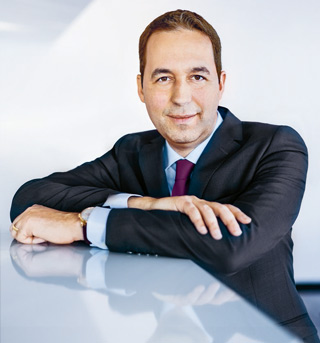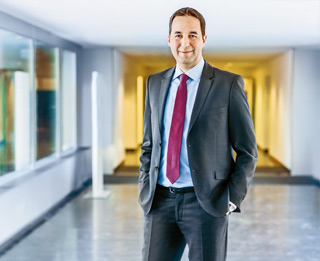Swiss Re is rapidly evolving.
Christian Mumenthaler explains his vision for the future.

“Swiss Re has always been one of the industry leaders, accumulating knowledge and data. This is now even more important than in the past.”
You took over as Group CEO in July last year. How have things evolved for the company since then?
The current environment is challenging. There is nothing we can do to completely avoid these challenges, but we are prepared for them. We see low economic growth around the world in a low interest rate environment, persistent pricing pressure on the Property & Casualty side and political uncertainties in many regions. But we still had a good performance in 2016 and that shows the strength of our franchise.
How did Swiss Re perform in 2016?
It was the first full year for our newest Business Unit, Life Capital, opening up many opportunities to grow in life and health. Even though Corporate Solutions had a challenging year, we made progress with our growth strategy: we bought IHC Risk Solutions in the US, opened an office in Kuala Lumpur, obtained an insurance license in Hong Kong, and signed an agreement with Bradesco Seguros, which will make us a leading commercial large-risk insurer in Brazil once the joint venture transaction is closed. In Reinsurance, large and tailored transactions continued to support growth.
What makes Swiss Re’s business model successful in this environment?
We need to distinguish among the different Business Units, but the common denominator is that Swiss Re has always been one of the industry leaders, accumulating knowledge and data. This is now even more important than in the past, because pure capital is, and will stay, plentiful. I am convinced that proprietary risk knowledge creates competitive advantage. In Reinsurance, our major strength is clearly the access we have to our clients’ C-suite, our financial strength and how we use knowledge to help clients grow. In Corporate Solutions, our knowledge helps us do better underwriting and select better risks. And for Life Capital, it’s the deep knowledge we have around biometric risk, paired with efficient technology-led systems and processes that focus on clients.
So what differentiates Swiss Re from others?
Swiss Re has a large amount of risk knowledge on topics such as pandemics, nuclear pools and natural catastrophes. Our teams have a deep understanding of medical indications, biometric trends and political risk. We may think that is normal, but it is not — it sets Swiss Re apart. The Swiss Re Institute is an evolution to structure our knowledge and deploy this strength to our clients. We are transitioning into a risk knowledge company that invests into risk pools with long-term growth potential.
What are ‘risk pools’ and how will the company access them?
Risk pools are the original risks, both people and goods, that can be insured. With global GDP growth, these pools are growing, especially in high growth markets, and this trend is likely to continue. The question is: who will insure these risks? As a reinsurer, we only access a fraction of the risk through our clients, so building access to risk pools is a key part of our strategy. One way is through Corporate Solutions, which has direct access to commercial clients. Another way is through Life Capital, where we are targeting the retail life risk pool. All of Life Capital’s activities, from ReAssure buying inforce books, to insuring pools of individuals with elipsLife and building up iptiQ as a very lean insurance company, create access to this risk pool.

How do reinsurance clients react to Swiss Re building up iptiQ?
IptiQ is a tool we put in the hands of insurance companies who are, for example, seeking access to markets. These clients want to profit from our technology and knowledge, but distribute products under their brand. We are not competing with our clients. Actually, we are supporting them.
Let’s take a step back. How do you see Swiss Re’s future prospects?
I think the long-term trends for the industry are positive. Insurance penetration is still low in many parts of the world, especially in high growth markets but also in industrialised countries. We are keen to close these protection gaps, which have different root causes. A first gap is where insurance is not available at all. In those regions, we work with governments or local institutions to insure people. The second gap is where insurance is available but people cannot afford it. In these areas, penetration is going up quite quickly and we support our insurance clients with our products. The third gap — the largest in terms of GDP impact — is in industrialised countries, where insurance is available and people can afford it but are still not buying it. California earthquake insurance is a good example: less than 12% of homeowners have insurance against earthquakes even though they are a major risk in the region.

Why is that?
We don’t know for sure. A possible explanation is the following: there is a widespread conviction that insurance is expensive, while in fact, surveys show people would be prepared to pay more than the actual price. There is also a belief that the state will help in case something like a major earthquake happens. And finally, people generally don’t like to think about insurance. This is a challenge for the insurance industry. The only way we can overcome it is by looking at the sales process and simplifying it. I think the day everybody has digital advisors, on a smartphone for example, is the day more people will start buying insurance.
The personal digital assistant is going to make rational decisions for them, based on their individual behaviours and situation. They will advise, recommend, select and purchase directly — that’s my digital assistant hypothesis. This, combined with simplified processes and more cost-effective offers, will help close the protection gap.
Swiss Re’s vision is to make the world more resilient. What does that mean in reality?
Every claim we pay for a family who lost somebody helps them to continue a more or less normal life — financially at least. Every payment in P&C helps to rebuild something that has been destroyed. One of the most visible examples in 2016 were the Canadian wildfires. They lasted for a long time and there was uncertainty about the damage, but we worked very closely with our customers in Canada, making payments as fast as possible so they could start the reconstruction. Every bit helps, but we have more work to do. For instance in Italy, a country I know very well for family reasons, only about 1% of residential buildings are insured against earthquakes and most of the destruction we saw in 2016 was not covered.
What is your personal vision for Swiss Re?
I would like to see Swiss Re positioned differently than just as an ordinary traditional reinsurance company. Ideally, in the future, when people hear ‘Swiss Re’, they will think of all our incredible knowledge that is so relevant for the future. We should never lose sight of where we want to go. Swiss Re is well positioned to be a long-term thinker and I am convinced that every activity focusing on the long term will be an advantage in a few years.
Zurich, 23 February 2017

Christian Mumenthaler
Group Chief Executive Officer